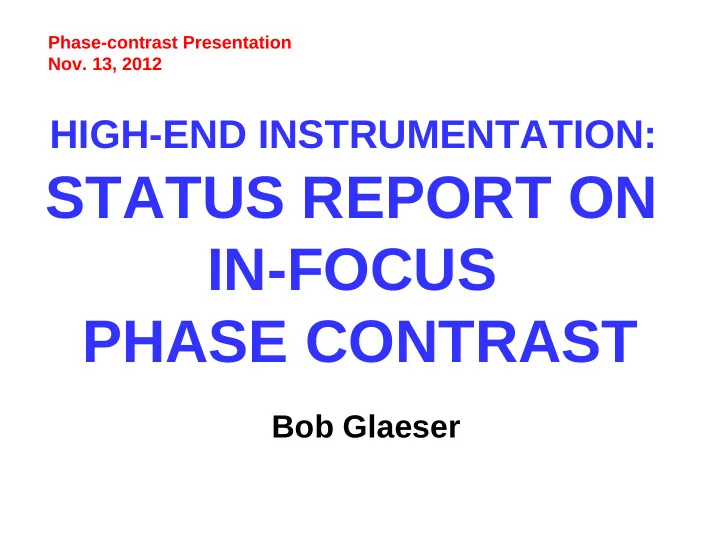

Phase-contrast Presentation Nov. 13, 2012 HIGH-END INSTRUMENTATION: STATUS REPORT ON IN-FOCUS PHASE CONTRAST Bob Glaeser
A THE “TULIP” APERTURE IS A “PASSIVE” PHASE-CONTRAST APERTURE, NOT A “PHASE PLATE” APERTURE CONTRAST = 0.5 IN SSB DOMAIN AND γ(s) SHOWS UP AS A PHASE ERROR Buijsse et al. (2011) Ultramicroscopy 111:1688-1695 B Cryo-EM images of the same area of a streptavidin monolayer crystal Both images taken with the same defocus value, close to Scherzer
STRUCTURE FACTORS FOR IQ plot “CTF-CORRECTED, UNBENT” IMAGES Merged data from ~15 streptavidin Spots with monolayer IQ 4 or less, crystals shown with numbers, have expected phase errors ~ 22° or less Outer circle is drawn at 3.0 Å: aperture is compatible with high resolution ~25,000 unit cells in this merged data H set of images recorded with the 1/20 1/10 1/7 1/5 1/4 1/3 (1/ Å K2 camera
MICROTUBULE DOUBLETS (Puey Onjai and Ken Downing) Note: much better contrast transfer for the low-resolution sections of layer lines that cross the DSB “gap” (didactic example of the effectivenesss of the SSB aperture)
NON-CRYSTALLINE REGION BETWEEN TWO SEPARATE CRYSTALS • You can spot individual streptavidn tetramers, Mr ~ 55k! • This capability should increase the coverage of proteome that is possible by a large factor- guestimate as much as 100X? • Results are similar to the best obtained with a thin carbon-film (“Zernicke”) phase plate • Similar problems are also encountered with – Unreliable manufacture In-focus image, tulip aperture – Short lifetime when there is a good one
MOTIVATION TO In-focus cryo-EM image of a 200 DEVELOP IN-FOCUS kDa homodimer PHASE CONTRAST Danev et al. (2009) Ultramicroscopy 109:312-325 • In-focus phase contrast of low- resolution features should be ~0.028 D, where D = particle diameter in nm Glaeser & Hall (2011) Biophys J. 100:2331-7 – Defocus contrast is only a few percent of this, due to the fact that its CTF falls to zero at low spatial frequencies • The increased SNR at low spatial frequencies should – Improve particle alignment and assignment of Euler angles, even for quite small particles – Improve assignment of structurally distinct particles into separate conformational or Simulation of potential alignment accuracy: compositional classes phase-contrast images of a 100 kDa protein Hall et al. (2011) J. Struct. Biol. 174:468-475
2-nm FEATURES MAY BE THE “DETECTABLE LIMIT” IN CRYO-EM TOMOGRAPHY (ρ particle – ρ ice ) values required for S/N > 3σ, for different voxel sizes and electron exposures p 0.5 nm 1 nm 2 nm 3 nm 5 nm (e nm -2 ) 30 31 7.7 1.9 0.86 0.31 100 17 4.3 1.1 0.48 0.17 300 10 2.5 0.62 0.27 0.10 10 3 5.4 1.4 0.34 0.15 0.06 3x10 3 3.1 0.79 0.19 0.09 0.03 10 4 Tomogram of a dimeric, 1.7 0.43 0.11 0.05 0.02 3x10 4 1.0 0.25 0.06 0.03 0.01 200 kDa particle suspended 10 5 0.54 0.14 0.04 0.02 0.006 In vitreous ice Danev & Glaeser, unpublished Table from: Glaeser & Hall (2011) Biophys J. 100:2331-2337 • In-focus phase-contrast EM tomography of suitably thin (weak-phase) objects should just barely reach a feature-detection limit of ~2 nm (Fourier resolution of 4 nm) • Density values must be multiplied by a factor of 14 for amplitude-contrast images Saxberg & Saxton (1981) Ultramicroscopy 6:85-90 – This would be the case for (incoherent) annular dark-field STEM images – It is also likely to be the case for CTEM images of thick specimens, even when a C c corrector is used
Avila-Sakar, A.J. and Chiu, W. (1996) Biophys J. 70:57-68 400 keV, film Close-to-focus image phases merged with diffraction amplitudes 3.0 Å map Han, B-G., Sassolini, S. and Glaeser, R.M., Unpublished 300 KV, K2 camera In-focus, “tulip” Phase-contrast aperture 3.0 Å map
Recommend
More recommend